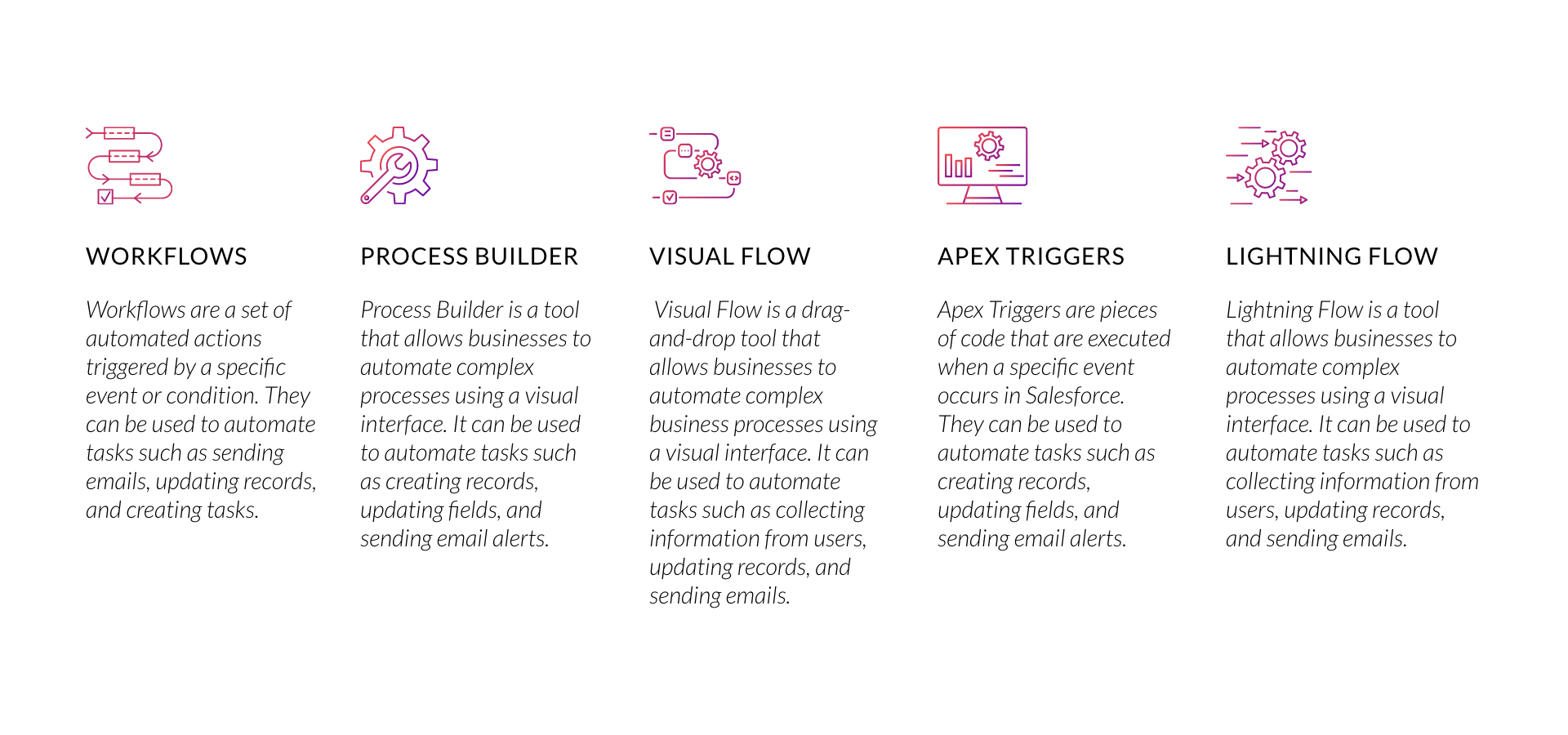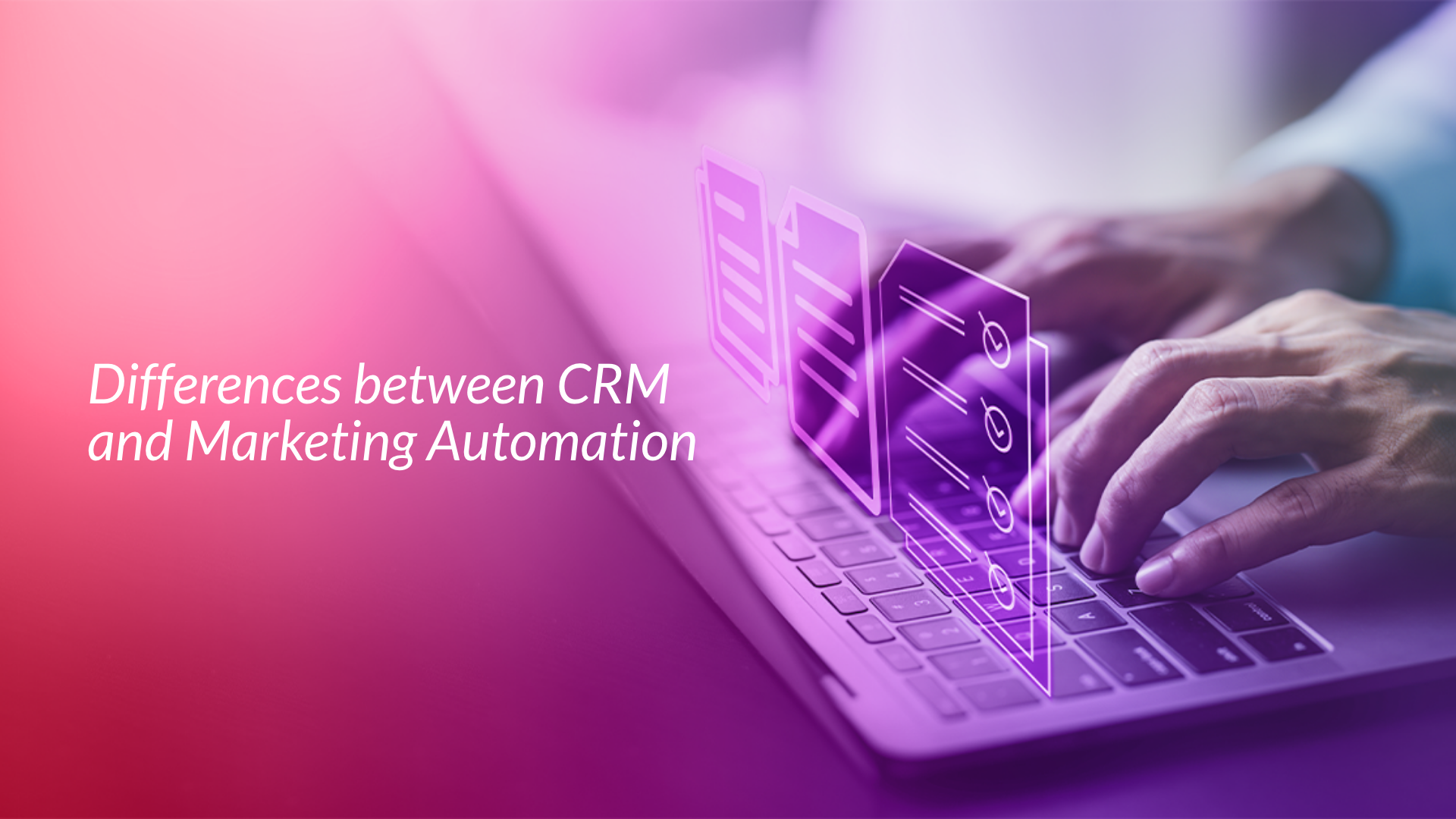Salesforce automation is a powerful tool that can streamline and simplify the sales and marketing process. By automating tasks and workflows, businesses can save time, reduce errors, and improve efficiency. In this article, we’ll explore what Salesforce automation is, how it works, and the various tools available to help businesses automate their processes. We’ll also answer common questions about Salesforce automation and cover key topics, including sales automation, marketing automation, and the differences between CRM and marketing automation.
Keywords and questions to be covered in this article include:
- What is Salesforce automation?
- What are the automation tools available in Salesforce?
- How do I create automation in Salesforce?
- Does Salesforce have sales automation?
- What is automation in Marketing Cloud?
- Does Salesforce have a marketing automation tool?
- What are the four types of automation?
- What is the difference between CRM and marketing automation?
Understanding Salesforce Automation
Salesforce automation is the use of technology to automate tasks and workflows in the Salesforce platform. This can include everything from lead generation and management, to customer service and support. By automating these processes, businesses can save time and resources, while also improving accuracy and efficiency.
Some of the key benefits of Salesforce automation include:
- Improved productivity: Automation allows businesses to focus on high-value tasks, while routine tasks are handled automatically.
- Reduced errors: Automation can help eliminate errors caused by manual data entry and other human errors.
- Improved customer experience: Automation can help businesses provide faster, more accurate service to customers, leading to higher satisfaction and loyalty.
- Better insights: Automation can help businesses gather and analyze data more efficiently, leading to better decision-making.
Salesforce automation tools include:
- Workflows: Workflows are a set of automated actions triggered by a specific event or condition. They can be used to automate tasks such as sending emails, updating records, and creating tasks.
- Process Builder: Process Builder is a tool that allows businesses to automate complex processes using a visual interface. It can be used to automate tasks such as creating records, updating fields, and sending email alerts.
- Visual Flow: Visual Flow is a drag-and-drop tool that allows businesses to automate complex business processes using a visual interface. It can be used to automate tasks such as collecting information from users, updating records, and sending emails.
- Apex Triggers: Apex Triggers are pieces of code that are executed when a specific event occurs in Salesforce. They can be used to automate tasks such as creating records, updating fields, and sending email alerts.
- Lightning Flow: Lightning Flow is a tool that allows businesses to automate complex processes using a visual interface. It can be used to automate tasks such as collecting information from users, updating records, and sending emails.

In the next section, we’ll explore how to create automation in Salesforce using these tools.
Automation Tools in Salesforce
Salesforce provides several tools to help businesses automate their workflows and processes. Here’s a closer look at some of the most commonly used tools:
- Workflows: Workflows are a set of automated actions triggered by a specific event or condition. They can be used to automate tasks such as sending emails, updating records, and creating tasks. Workflows are simple to set up and can be used to automate a variety of tasks.
- Process Builder: Process Builder is a tool that allows businesses to automate complex processes using a visual interface. It can be used to automate tasks such as creating records, updating fields, and sending email alerts. Process Builder is particularly useful for businesses that need to automate processes that involve multiple steps.
- Visual Flow: Visual Flow is a drag-and-drop tool that allows businesses to automate complex business processes using a visual interface. It can be used to automate tasks such as collecting information from users, updating records, and sending emails. Visual Flow is particularly useful for businesses that need to automate processes that involve user interaction.
- Apex Triggers: Apex Triggers are pieces of code that are executed when a specific event occurs in Salesforce. They can be used to automate tasks such as creating records, updating fields, and sending email alerts. Apex Triggers are particularly useful for businesses that need to automate processes that require complex logic.
- Lightning Flow: Lightning Flow is a tool that allows businesses to automate complex processes using a visual interface. It can be used to automate tasks such as collecting information from users, updating records, and sending emails. Lightning Flow is particularly useful for businesses that need to automate processes that involve user interaction and require a high degree of customization.
Each of these automation tools has its strengths and weaknesses, and businesses should choose the tool that best suits their needs. In the next section, we’ll explore how to create automation in Salesforce using these tools.
Creating Automation in Salesforce
Once you have an understanding of the Salesforce automation tools available, the next step is to actually start creating with those tools. Here are the general steps to follow when creating automation in Salesforce:
- Identify the process that needs automation: The first step is to identify the manual process that you want to automate. This could be anything from creating records to updating fields.
- Choose the automation tool: Once you’ve identified the process, you can choose the automation tool that best suits your needs. Consider factors such as complexity, user interaction, and customization requirements.
- Configure the automation tool: Once you’ve chosen the automation tool, you’ll need to configure it to automate the desired process. This typically involves defining the trigger, specifying the actions to be taken, and setting up any necessary conditions or criteria.
- Test the automation: Once you’ve configured the automation tool, you’ll need to test it to ensure that it’s working as expected. This typically involves creating test records and verifying that the automation is triggered and the correct actions are taken.
Examples of automation in Salesforce:
- Lead nurturing: When a lead is created in Salesforce, a workflow can be triggered to send a series of emails to the lead over time, providing them with relevant information and nurturing them towards a sale.
- Opportunity management: When an opportunity is closed-won in Salesforce, a process builder can be used to update related records, such as creating a new order and sending an email to the sales rep.
- Case management: When a case is created in Salesforce, an Apex Trigger can be used to assign the case to the appropriate support agent based on the case details.
By automating these processes, businesses can save time and improve efficiency, allowing them to focus on more strategic initiatives. In the next section, we’ll explore some common questions related to Salesforce automation.
Salesforce Sales Automation
Salesforce automation isn’t just limited to marketing – it can also be used for sales automation. In general, sales automation involves removing manual steps from the sales process to improve efficiency and streamline operations. With Salesforce, businesses can automate sales processes such as lead management, opportunity management, and quote management. By eliminating the hands on time typically associated with these processes, businesses can save time and increase revenue.
Here are some of the tools available for sales automation in Salesforce:
- Sales Cloud: Salesforce’s Sales Cloud is a customer relationship management (CRM) platform that provides sales automation tools such as lead management, opportunity management, and quote management.
- Einstein AI: Salesforce’s Einstein AI provides artificial intelligence (AI) capabilities that can be used to automate sales processes such as lead scoring, opportunity scoring, and forecasting.
- Pardot: Pardot is a marketing automation platform that can also be used for sales automation. It provides tools such as lead nurturing, lead scoring, and email marketing.
Benefits of using sales automation in Salesforce:
- Improved efficiency: Sales automation can help businesses save time and improve efficiency by automating manual processes.
- Increased revenue: By automating sales processes such as lead management and opportunity management, businesses can increase revenue by closing more deals.
- Better customer experience: Sales automation can help businesses provide a better customer experience by providing more personalized and timely communications.
In the next section, we’ll explore some common questions related to marketing automation in Salesforce.

Salesforce Marketing Automation
Marketing automation is another key area where Salesforce automation can be incredibly beneficial. Here’s an overview of marketing automation in Salesforce:
Marketing automation involves automating marketing processes to improve efficiency and increase revenue. With Salesforce, businesses can automate marketing processes such as lead nurturing, email marketing, and campaign management. By automating these processes, businesses can save time and increase revenue.
Here are some of the tools available for marketing automation in Salesforce:
- Marketing Cloud: Salesforce’s Marketing Cloud is a marketing automation platform that provides tools for email marketing, social media marketing, mobile marketing, and more.
- Pardot: As mentioned earlier, Pardot is a marketing automation platform that can also be used for sales automation. It provides tools such as lead nurturing, lead scoring, and email marketing.
- Journey Builder: Journey Builder is a tool in Marketing Cloud that allows businesses to create personalized customer journeys across multiple channels such as email, SMS, and social media.
Benefits of using marketing automation in Salesforce:
- Increased efficiency: Marketing automation can help businesses save time and increase efficiency by automating manual processes such as lead nurturing and campaign management.
- Improved lead quality: By automating lead nurturing processes, businesses can ensure that leads are receiving timely and relevant communications, which can improve lead quality.
Higher conversion rates: Marketing automation can help businesses increase conversion rates by delivering more personalized and timely communications to leads and customers. In the next section, we’ll answer some common questions related to Salesforce automation.
Differences between CRM and Marketing Automation
While both CRM and marketing automation are important tools for managing customer relationships, there are some key differences between the two. Here’s an overview:
Customer Relationship Management (CRM)
CRM is a tool for managing customer relationships, including sales, customer service, and support. CRM systems help businesses manage customer data, track interactions with customers, and automate certain processes such as lead tracking and sales forecasting. CRM systems are primarily used by sales teams and customer support teams to manage customer interactions.
Marketing Automation
Marketing automation, on the other hand, is a tool for automating marketing processes such as lead generation, lead nurturing, and campaign management. Marketing automation systems help businesses create and manage marketing campaigns, track customer behavior, and automate certain marketing processes. Marketing automation systems are primarily used by marketing teams to manage the customer journey.
Key Differences
Here are some key differences between CRM and marketing automation:
- Focus: CRM systems focus on managing customer interactions across multiple touchpoints, while marketing automation systems focus on automating marketing processes.
- Teams: CRM systems are primarily used by sales teams and customer support teams, while marketing automation systems are primarily used by marketing teams.
- Data: CRM systems typically include customer data such as contact information, purchase history, and customer interactions, while marketing automation systems typically include data such as website behavior, email interactions, and social media activity.
- Processes: CRM systems typically focus on managing customer interactions such as sales and support, while marketing automation systems focus on automating marketing processes such as lead generation and lead nurturing.
Understanding the differences between CRM and marketing automation is important for businesses looking to implement these tools. While both tools are important for managing customer relationships, they have different use cases and require different strategies for implementation.
Types of Automation
There are four types of automation that are commonly used in Salesforce:
- Workflow Automation: Workflow automation is used to automate a series of actions based on predefined criteria. For example, when a lead is assigned to a sales rep, a workflow can be triggered to send an email to the lead with a personalized message.
- Process Automation: Process automation is used to automate complex business processes that involve multiple steps and actions. For example, when a new account is created, a process can be triggered to assign the account to a sales rep, create a follow-up task, and update the account status.
- Visual Flow Automation: Visual flow automation is used to create custom, interactive screens that guide users through a series of steps. For example, a visual flow can be used to create a custom onboarding process for new customers.
- Apex Triggers: Apex triggers are used to automate processes that are not supported by the standard Salesforce automation tools. For example, an Apex trigger can be used to update a custom field on an object based on changes to a related object.
Each type of automation has its own use cases and benefits, and businesses can use a combination of these automation tools to create custom workflows and processes that meet their specific needs.
In Salesforce, these automation tools can be used to streamline sales and marketing processes, automate lead management and lead nurturing, and improve customer engagement and retention. By automating these processes, businesses can save time, reduce errors, and improve overall efficiency.
Challenges with Salesforce Automation
While Salesforce automation can bring numerous benefits to businesses, there are also common challenges that they can face. Here are some of the challenges and strategies to overcome them:
- Complexity: Salesforce automation can be complex, especially for businesses with large and complex sales and marketing processes. To overcome this challenge, it’s important to have a clear understanding of the business processes and identify the specific tasks that need to be automated.
- Resistance to change: Some employees may resist the implementation of Salesforce automation, which can impact adoption rates. To overcome this challenge, businesses can provide training and support to help employees understand the benefits of automation and how to use the new tools.
- Data quality: Salesforce automation relies on accurate and up-to-date data. If the data is not clean, consistent, and complete, the automation process can fail. To overcome this challenge, businesses need to establish data quality procedures and implement regular data hygiene practices.
- Cost: Implementing Salesforce automation can be costly, especially for small businesses with limited resources. To overcome this challenge, businesses can start with small, low-cost automation projects and gradually scale up as they see results.
By understanding these challenges and implementing strategies to overcome them, businesses can successfully implement Salesforce automation and enjoy its benefits.
Conclusion
In this article, we’ve explored the world of Salesforce automation, including its definition, benefits, and various tools available to businesses. We’ve covered the steps to create automation in Salesforce and provided examples of how it can be used in sales and marketing processes.
We also highlighted the differences between CRM and marketing automation, as well as the four types of automation and how they are used in Salesforce.
While there are challenges that businesses may face when implementing Salesforce automation, such as complexity and resistance to change, there are strategies to overcome these challenges and achieve success.
In today’s fast-paced business environment, it’s essential to leverage the latest tools and technologies to stay competitive. Salesforce automation can help businesses streamline their sales and marketing processes, improve efficiency, and drive growth.
Overall, Salesforce automation is a powerful tool that can revolutionize the way businesses operate, and it’s essential for modern companies to embrace this technology to remain competitive in today’s marketplace. Get in touch with Bridgenext (formerly DEFINITION 6) today to leverage our world class automation expertise and unique Salesforce partnership. We can help you transform your business to achieve meaningful business growth and efficiency.



